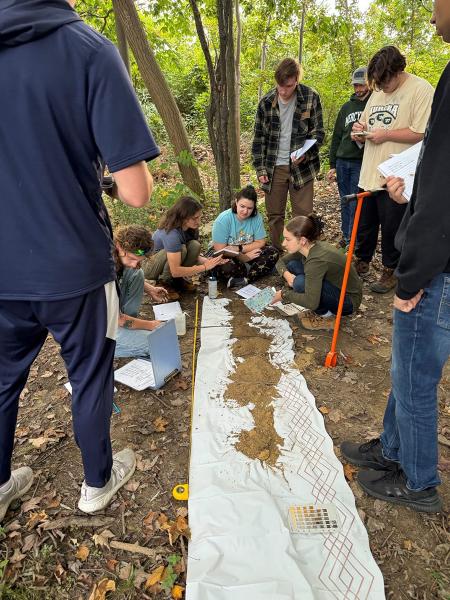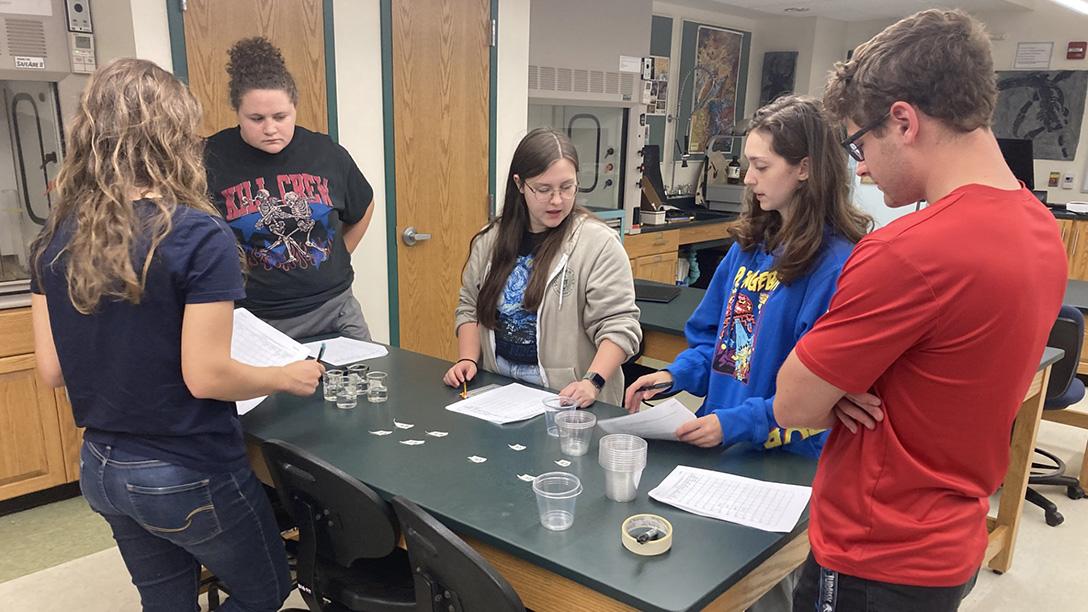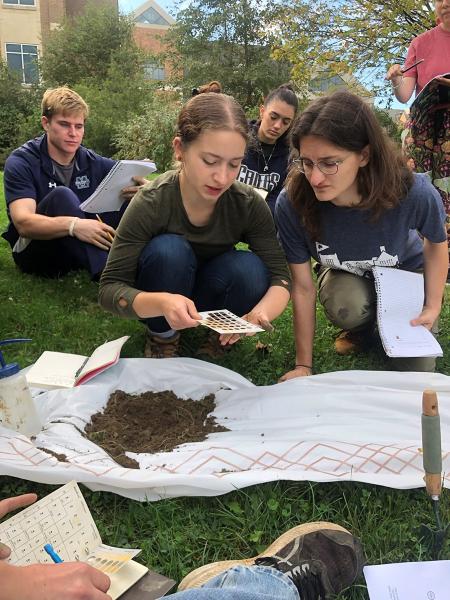Geology
Geology is the study of the Earth and how it works. Specifically, geologists seek to answer questions as diverse as “How did this mountain form?” and “When will this volcano erupt again?” to “How do we provide clean drinking water?” Geologists work at the interface between human-kind and the Earth and are on the front line in solving a multitude of energy and environmental issues. Geologists use knowledge of math, chemistry, physics, and biology to answer these questions and gain first-hand experience working in the field. Graduates are employed by government agencies, such as the USGS and DEP, educational institutions, oil and mining companies, and environmental consulting firms.
Why Geology?
Students majoring in Geology will be preparing themselves to take an active role in the utilization of the earth's resources while protecting its fragile environment. Course work involves hands-on use of modern laboratory equipment and extensive projects out in the field. The faculty combines the use of small class sizes and abundant travel opportunities with a commitment to involving students in ongoing geological projects that involve both local and far-ranging locales. The curricula are designed with three primary objectives:
- Prepare students for entry-level employment with consulting and industry that concentrates on environmental problems
- Prepare students for entry-level employment in federal, state, and municipal environmental agencies
- Prepare students to enter graduate programs in a branch of geology in preparation for a career in academia or upper-level employment with private companies or governmental agencies
- The department offers courses leading to the Bachelor of Science (B.S.) or Bachelor of Arts (B.A.) degrees in Geology. To be recommended for graduation, students must earn at least a 2.5 GPA in their major. A student also must earn a grade of at least C in any Geology course that is taken to fulfill a degree requirement. One must earn at least a D in each required cognate
How to get Started
Try our introductory geology class – Dynamic Earth! Counts for the geology major, as well as REACH curriculum.
Fast Facts
- The Geology department leads one large trip per year for students. Past trips have gone to Death Valley National Park, Yellowstone National Park, Costa Rica, as well as Italy and Greece
- Geologists travel all around the world performing work at sea, on the top of mountains, in deserts, in underground caves, and in laboratories
- Mercyhurst geology majors routinely present their original research at national conferences and have been internationally recognized for their efforts
- The Mercyhurst Geology Club leads multiple field trips a year to go fossil and mineral collecting in Pennsylvania, Ohio, and New York
- Follow the course catalog to see department offerings and curriculum
- Follow the course catalog to see department offerings and curriculum
Students pursuing a Bachelor of Science in Geology often go into research-heavy fields with an emphasis on direct application of geology principles.
Students pursuing a Bachelor of Arts in Geology often go into K-12 teaching and policy-related fields.
- GEOL 100/102: Dynamic Earth & Lab (4 credits)
- Four additional geology courses with at least three numbered 200 or higher are required
- SCI 225: Oceanography may count towards the geology minor
- Follow the course catalog to see department offerings and curriculum
Learning Outcomes
- Explain:
- Paradigms that shape current geologic thought (e.g., plate tectonics)
- Concept of geologic time and detail the geologic time scale for the Earth
- The processes that have shaped and continue to shape the Earth
- Identify:
- Significant geologic features on the Earth and place them into their appropriate geologic context
- Common rocks and minerals found on and inside the Earth using hand samples and thin sections
- Associate common rocks and minerals found on and inside the Earth with their appropriate geologic context
- Formulate and communicate an effective scientific argument through written and oral means
- Demonstrate the ability to organize and conduct geology-related field and laboratory work
State Authorization
This program may fulfill a portion of the examination pre-qualification for the Professional Geologist license. Please visit the State Authorization webpage to review the requirements for licensure by state or program.
This room serves as our space for preparing rocks, minerals, fossils, and other geologic materials for teaching and research. The room features diamond saws, rock polishers, and a thin section machine for the study of rocks, as well as a Roto-Tap sieve shaker for measurement of coarse-grained sediment samples.
This state-of-the-art geology smart classroom seats twenty-four students and includes an extensive rock and mineral collection for classroom use, petrographic microscopes for the study of thin section slides, and a library of geology-related textbooks.
This classroom serves as our lab space for research and teaching in the geologic sub-disciplines of paleoclimatology and surficial processes. The space is equipped with two fume hoods for sample preparation, a muffle furnace for analysis of organic and inorganic carbon content, a Coulter Counter laser diffraction unit for the measurement of sediment grain size, our collection of topographic and physiographic maps, and a Darcy tube for groundwater flow demonstrations.
Student Research
Rickets, A., & Lang, N.P. (2024), Attributes of Streamlined Islands in Venusian Channels: Implications for Their Origin and Use as a Flow Direction Indicators; Geological Society of America Abstracts with Programs. Vol 56, No. 5, doi: 10.1130/abs/2024AM-404455
McKenzie, S., Miller, J., & Baltozer, A. (2023), Glass Diversity at the Wanapitei Impact Site in Ontario. Geological Society of America Abstracts with Programs, Vol. 55, No. 6, doi: 10.1130/abs/2023AM-391635
Collins, T. P., McKenzie, S. (2020), A new fossil of Miracinonyx Inexpectatus from the Haille Quarries in Alahachua County, Florida; Geological Society of America Abstracts with Programs. Vol 52, No. 6, doi: 10.1130/abs/2020AM-359877
Tamez-Galvan, E., McKenzie, S. (2020), Overview of the Bear Gulch laggerstatte, Fergus County, Montana; Geological Society of America Abstracts with Programs. Vol 52, No. 6, doi: 10.1130/abs/2020AM-357312
Lang, N.P., and 14 others including 11 former students (2019), Unraveling volcanic and related processes using remotely sensed data sets: Perspectives from a Miocene-aged volcanic terrain in northwest Arizona; in Pearthree, P.A., ed., Geol. Soc. of America Field Guide 55, p. 273-305, doi: 10.1130/2019.0055 (10)
Nypaver, C.A., Lang, N.P., and Thomson, B.J. (2018), Constraints on geologic processes recorded in venusian shield fields: Insights into the processes related to their formation, in Poland, M., Garcia, M., Camp, V., and Grunder, A., eds., Field Volcanology: A Tribute to the Distinguished Career of Don Swanson: Geological Society of America Special Paper 538, p. 435–458, https://doi.org/10.1130/2018.2538(20)
What is geology? Examining the earth and its composition, history, and its effects on human life is the study of geology (authored by Lowell Bradford).
This link is great for educators looking for specific lesson plans and course content ideas and strategies. This site also includes useful information for those looking for careers in academia.
Pennsylvania Spatial Data Access (PASDA) is the official public access geospatial information clearinghouse for the Commonwealth of Pennsylvania and has served for twelve years as Pennsylvania's node on the National Spatial Data Infrastructure, Geospatial One-Stop, and the National Biological Information Infrastructure.
Your source for science you can use as an unbiased, multi-disciplinary science organization that focuses on biology, geography, geology, geospatial information, and water, we are dedicated to the timely, relevant, and impartial study of the landscape, our natural resources, and the natural hazards that threaten us. Learn more about our goals and priorities for the coming decade in our Science Strategy.
NASA's mission is to pioneer the future in space exploration, scientific discovery, and aeronautics research.
Carnegie Museum of Natural History is a place of adventure, discovery, and education that welcomes everyone to enjoy the wonders of its collections and exhibits. Founded in 1895 by Andrew Carnegie, the museum has maintained an international reputation for its ongoing research and discovery that create a better understanding of the history of the earth and its inhabitants. Today, the museum is ranked among the top five natural history museums in the country and features 20 exhibit halls including the blockbuster Dinosaurs in Their Time.
Established in 1888, The Geological Society of America provides access to elements that are essential to the professional growth of earth scientists at all levels of expertise and from all sectors: academic, government, business, and industry. GSA’s mission is to be a leader in advancing geosciences, enhancing the professional growth of its members, and promoting geosciences in the service to humankind and stewardship of the Earth.
Dr. Ron Brown, Ph.D.
Chair, Department of Biochemical and Physical Science
Office: Zurn 305
Meet the Faculty
Geology













